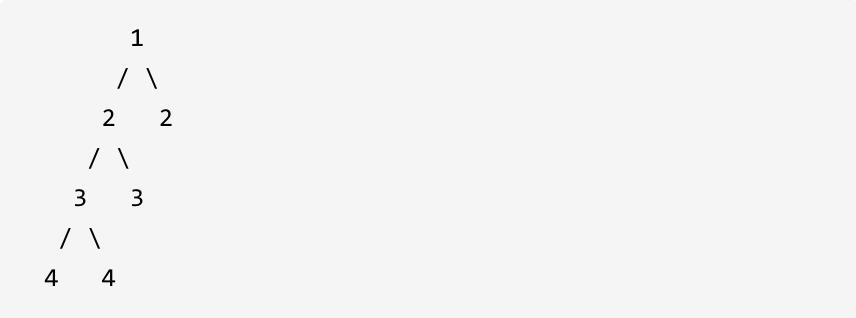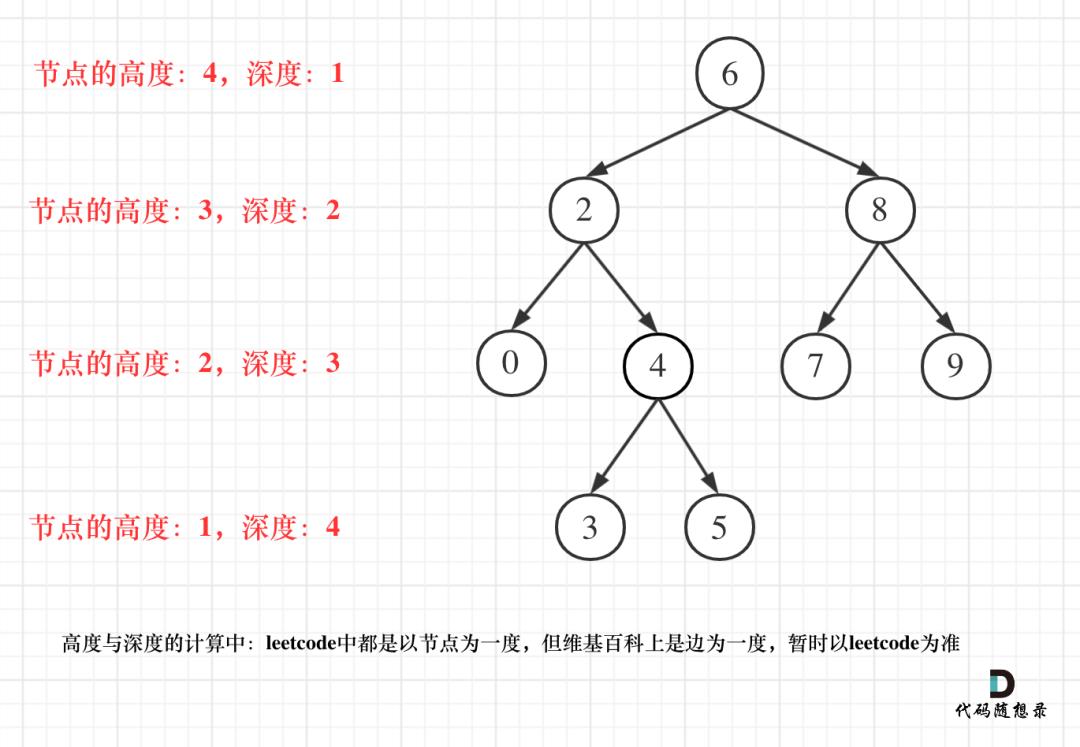二叉树:我平衡么?
Posted 代码随想录
tags:
篇首语:本文由小常识网(cha138.com)小编为大家整理,主要介绍了二叉树:我平衡么?相关的知识,希望对你有一定的参考价值。
❝平不平衡看高度,注意不是深度。
❞
110.平衡二叉树
给定一个二叉树,判断它是否是高度平衡的二叉树。
本题中,一棵高度平衡二叉树定义为:一个二叉树每个节点 的左右两个子树的高度差的绝对值不超过1。
示例 1:
给定二叉树 [3,9,20,null,null,15,7]

返回 true 。
示例 2:
给定二叉树 [1,2,2,3,3,null,null,4,4]

返回 false 。
题外话
咋眼一看这道题目和很像,其实有很大区别。
这里强调一波概念:
-
二叉树节点的深度:指从根节点到该节点的最长简单路径边的条数。 -
二叉树节点的高度:指从该节点到叶子节点的最长简单路径边的条数。
但leetcode中强调的深度和高度很明显是按照节点来计算的,如图:

关于根节点的深度究竟是1 还是 0,不同的地方有不一样的标准,leetcode的题目中都是以节点为一度,即根节点深度是1。但维基百科上定义用边为一度,即根节点的深度是0,我们暂时以leetcode为准(毕竟要在这上面刷题)。
因为求深度可以从上到下去查 所以需要前序遍历(中左右),而高度只能从下到上去查,所以只能后序遍历(左右中)
有的同学一定疑惑,为什么中求的是二叉树的最大深度,也用的是后序遍历。
「那是因为代码的逻辑其实是求的根节点的高度,而根节点的高度就是这颗树的最大深度,所以才可以使用后序遍历。」
在中,如果真正求取二叉树的最大深度,代码应该写成如下:(前序遍历)
class Solution {
public:
int result;
void getDepth(TreeNode* node, int depth) {
result = depth > result ? depth : result; // 中
if (node->left == NULL && node->right == NULL) return ;
if (node->left) { // 左
depth++; // 深度+1
getDepth(node->left, depth);
depth--; // 回溯,深度-1
}
if (node->right) { // 右
depth++; // 深度+1
getDepth(node->right, depth);
depth--; // 回溯,深度-1
}
return ;
}
int maxDepth(TreeNode* root) {
result = 0;
if (root == 0) return result;
getDepth(root, 1);
return result;
}
};
「可以看出使用了前序(中左右)的遍历顺序,这才是真正求深度的逻辑!」
注意以上代码是为了把细节体现出来,简化一下代码如下:
class Solution {
public:
int result;
void getDepth(TreeNode* node, int depth) {
result = depth > result ? depth : result; // 中
if (node->left == NULL && node->right == NULL) return ;
if (node->left) { // 左
getDepth(node->left, depth + 1);
}
if (node->right) { // 右
getDepth(node->right, depth + 1);
}
return ;
}
int maxDepth(TreeNode* root) {
result = 0;
if (root == 0) return result;
getDepth(root, 1);
return result;
}
};
本题思路
递归
此时大家应该明白了既然要求比较高度,必然是要后序遍历。
递归三步曲分析:
-
明确递归函数的参数和返回值
参数的话为传入的节点指针,就没有其他参数需要传递了,返回值要返回传入节点为根节点树的深度。
那么如何标记左右子树是否差值大于1呢。
如果当前传入节点为根节点的二叉树已经不是二叉平衡树了,还返回高度的话就没有意义了。
所以如果已经不是二叉平衡树了,可以返回-1 来标记已经不符合平衡树的规则了。
代码如下:
// -1 表示已经不是平衡二叉树了,否则返回值是以该节点为根节点树的高度
int getDepth(TreeNode* node)
-
明确终止条件
递归的过程中依然是遇到空节点了为终止,返回0,表示当前节点为根节点的高度为0
代码如下:
if (node == NULL) {
return 0;
}
-
明确单层递归的逻辑
如何判断当前传入节点为根节点的二叉树是否是平衡二叉树呢,当然是左子树高度和右子树高度相差。
分别求出左右子树的高度,然后如果差值小于等于1,则返回当前二叉树的高度,否则则返回-1,表示已经不是二叉树了。
代码如下:
int leftDepth = depth(node->left); // 左
if (leftDepth == -1) return -1;
int rightDepth = depth(node->right); // 右
if (rightDepth == -1) return -1;
int result;
if (abs(leftDepth - rightDepth) > 1) { // 中
result = -1;
} else {
result = 1 + max(leftDepth, rightDepth); // 以当前节点为根节点的最大高度
}
return result;
代码精简之后如下:
int leftDepth = getDepth(node->left);
if (leftDepth == -1) return -1;
int rightDepth = getDepth(node->right);
if (rightDepth == -1) return -1;
return abs(leftDepth - rightDepth) > 1 ? -1 : 1 + max(leftDepth, rightDepth);
此时递归的函数就已经写出来了,这个递归的函数传入节点指针,返回以该节点为根节点的二叉树的高度,如果不是二叉平衡树,则返回-1。
getDepth整体代码如下:
int getDepth(TreeNode* node) {
if (node == NULL) {
return 0;
}
int leftDepth = getDepth(node->left);
if (leftDepth == -1) return -1;
int rightDepth = getDepth(node->right);
if (rightDepth == -1) return -1;
return abs(leftDepth - rightDepth) > 1 ? -1 : 1 + max(leftDepth, rightDepth);
}
最后本题整体递归代码如下:
class Solution {
public:
// 返回以该节点为根节点的二叉树的高度,如果不是二叉搜索树了则返回-1
int getDepth(TreeNode* node) {
if (node == NULL) {
return 0;
}
int leftDepth = getDepth(node->left);
if (leftDepth == -1) return -1; // 说明左子树已经不是二叉平衡树
int rightDepth = getDepth(node->right);
if (rightDepth == -1) return -1; // 说明右子树已经不是二叉平衡树
return abs(leftDepth - rightDepth) > 1 ? -1 : 1 + max(leftDepth, rightDepth);
}
bool isBalanced(TreeNode* root) {
return getDepth(root) == -1 ? false : true;
}
};
迭代
在中我们可以使用层序遍历来求深度,但是就不能直接用层序遍历来求高度了,这就体现出求高度和求深度的不同。
本题的迭代方式可以先定义一个函数,专门用来求高度。
这个函数通过栈模拟的后序遍历找每一个节点的高度(其实是通过求传入节点为根节点的最大深度来求的高度)
代码如下:
// cur节点的最大深度,就是cur的高度
int getDepth(TreeNode* cur) {
stack<TreeNode*> st;
if (cur != NULL) st.push(cur);
int depth = 0; // 记录深度
int result = 0;
while (!st.empty()) {
TreeNode* node = st.top();
if (node != NULL) {
st.pop();
st.push(node); // 中
st.push(NULL);
depth++;
if (node->right) st.push(node->right); // 右
if (node->left) st.push(node->left); // 左
} else {
st.pop();
node = st.top();
st.pop();
depth--;
}
result = result > depth ? result : depth;
}
return result;
}
然后再用栈来模拟前序遍历,遍历每一个节点的时候,再去判断左右孩子的高度是否符合,代码如下:
bool isBalanced(TreeNode* root) {
stack<TreeNode*> st;
if (root == NULL) return true;
st.push(root);
while (!st.empty()) {
TreeNode* node = st.top(); // 中
st.pop();
if (abs(getDepth(node->left) - getDepth(node->right)) > 1) { // 判断左右孩子高度是否符合
return false;
}
if (node->right) st.push(node->right); // 右(空节点不入栈)
if (node->left) st.push(node->left); // 左(空节点不入栈)
}
return true;
}
整体代码如下:
class Solution {
private:
int getDepth(TreeNode* cur) {
stack<TreeNode*> st;
if (cur != NULL) st.push(cur);
int depth = 0; // 记录深度
int result = 0;
while (!st.empty()) {
TreeNode* node = st.top();
if (node != NULL) {
st.pop();
st.push(node); // 中
st.push(NULL);
depth++;
if (node->right) st.push(node->right); // 右
if (node->left) st.push(node->left); // 左
} else {
st.pop();
node = st.top();
st.pop();
depth--;
}
result = result > depth ? result : depth;
}
return result;
}
public:
bool isBalanced(TreeNode* root) {
stack<TreeNode*> st;
if (root == NULL) return true;
st.push(root);
while (!st.empty()) {
TreeNode* node = st.top(); // 中
st.pop();
if (abs(getDepth(node->left) - getDepth(node->right)) > 1) {
return false;
}
if (node->right) st.push(node->right); // 右(空节点不入栈)
if (node->left) st.push(node->left); // 左(空节点不入栈)
}
return true;
}
};
当然此题用迭代法,其实效率很低,因为没有很好的模拟回溯的过程,所以迭代法有很多重复的计算。
虽然理论上所有的递归都可以用迭代来实现,但是有的场景难度可能比较大。
「例如:都知道回溯法其实就是递归,但是很少人用迭代的方式去实现回溯算法!」
因为对于回溯算法已经是非常复杂的递归了,如果在用迭代的话,就是自己给自己找麻烦,效率也并不一定高。
总结
通过本题可以了解求二叉树深度 和 二叉树高度的差异,求深度适合用前序遍历,而求高度适合用后序遍历。
本题迭代法其实有点复杂,大家可以有一个思路,也不一定说非要写出来。
但是递归方式是一定要掌握的!
在留言区留下你的思路吧!
-------end-------
我将算法学习相关的资料已经整理到了Github :https://github.com/youngyangyang04/leetcode-master,里面还有leetcode刷题攻略、各个类型经典题目刷题顺序、思维导图看一看一定会有所收获,如果给你有帮助给一个star支持一下吧!
每天8:35准时推送一道经典算法题目,推送的每道题目都不是孤立的,而是由浅入深,环环相扣,帮你梳理算法知识脉络,轻松学算法!

以上是关于二叉树:我平衡么?的主要内容,如果未能解决你的问题,请参考以下文章